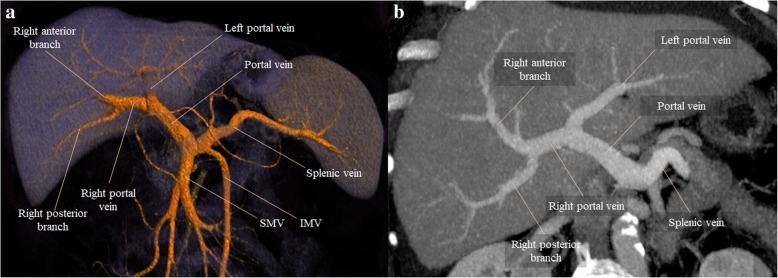[1]
Granger DN, Holm L, Kvietys P. The Gastrointestinal Circulation: Physiology and Pathophysiology. Comprehensive Physiology. 2015 Jul 1:5(3):1541-83. doi: 10.1002/cphy.c150007. Epub
[PubMed PMID: 26140727]
[2]
Carneiro C, Brito J, Bilreiro C, Barros M, Bahia C, Santiago I, Caseiro-Alves F. All about portal vein: a pictorial display to anatomy, variants and physiopathology. Insights into imaging. 2019 Mar 21:10(1):38. doi: 10.1186/s13244-019-0716-8. Epub 2019 Mar 21
[PubMed PMID: 30900187]
Level 3 (low-level) evidence
[4]
Gallego C, Velasco M, Marcuello P, Tejedor D, De Campo L, Friera A. Congenital and acquired anomalies of the portal venous system. Radiographics : a review publication of the Radiological Society of North America, Inc. 2002 Jan-Feb:22(1):141-59
[PubMed PMID: 11796904]
[5]
Thornburg B, Desai K, Hickey R, Kulik L, Ganger D, Baker T, Abecassis M, Lewandowski RJ, Salem R. Portal Vein Recanalization and Transjugular Intrahepatic Portosystemic Shunt Creation for Chronic Portal Vein Thrombosis: Technical Considerations. Techniques in vascular and interventional radiology. 2016 Mar:19(1):52-60. doi: 10.1053/j.tvir.2016.01.006. Epub 2016 Feb 6
[PubMed PMID: 26997089]
[6]
Thornburg B, Desai K, Hickey R, Hohlastos E, Kulik L, Ganger D, Baker T, Abecassis M, Caicedo JC, Ladner D, Fryer J, Riaz A, Lewandowski RJ, Salem R. Pretransplantation Portal Vein Recanalization and Transjugular Intrahepatic Portosystemic Shunt Creation for Chronic Portal Vein Thrombosis: Final Analysis of a 61-Patient Cohort. Journal of vascular and interventional radiology : JVIR. 2017 Dec:28(12):1714-1721.e2. doi: 10.1016/j.jvir.2017.08.005. Epub 2017 Oct 17
[PubMed PMID: 29050854]
[7]
Imamura H, Kokudo N, Sugawara Y, Sano K, Kaneko J, Takayama T, Makuuchi M. Pringle's maneuver and selective inflow occlusion in living donor liver hepatectomy. Liver transplantation : official publication of the American Association for the Study of Liver Diseases and the International Liver Transplantation Society. 2004 Jun:10(6):771-8
[PubMed PMID: 15162472]
[8]
Simonetto DA, Liu M, Kamath PS. Portal Hypertension and Related Complications: Diagnosis and Management. Mayo Clinic proceedings. 2019 Apr:94(4):714-726. doi: 10.1016/j.mayocp.2018.12.020. Epub
[PubMed PMID: 30947834]
[9]
Pillebout E. [Hepatorenal syndrome]. Nephrologie & therapeutique. 2014 Feb:10(1):61-8. doi: 10.1016/j.nephro.2013.11.005. Epub 2014 Jan 1
[PubMed PMID: 24388293]
[10]
Facciorusso A, Chandar AK, Murad MH, Prokop LJ, Muscatiello N, Kamath PS, Singh S. Comparative efficacy of pharmacological strategies for management of type 1 hepatorenal syndrome: a systematic review and network meta-analysis. The lancet. Gastroenterology & hepatology. 2017 Feb:2(2):94-102. doi: 10.1016/S2468-1253(16)30157-1. Epub 2016 Dec 2
[PubMed PMID: 28403995]
Level 2 (mid-level) evidence
[11]
Piron L, Deshayes E, Escal L, Souche R, Herrero A, Pierredon-Foulongne MA, Assenat E, le Lam N, Quenet F, Guiu B. [Portal vein embolization: Present and future]. Bulletin du cancer. 2017 May:104(5):407-416. doi: 10.1016/j.bulcan.2017.03.009. Epub 2017 May 3
[PubMed PMID: 28477870]
[12]
Haris M, Thachil J. Portal vein thrombosis - a primer for the general physician. Clinical medicine (London, England). 2017 Jun:17(3):212-219. doi: 10.7861/clinmedicine.17-3-212. Epub
[PubMed PMID: 28572222]
[13]
Basit SA, Stone CD, Gish R. Portal vein thrombosis. Clinics in liver disease. 2015 Feb:19(1):199-221. doi: 10.1016/j.cld.2014.09.012. Epub 2014 Oct 30
[PubMed PMID: 25454305]

